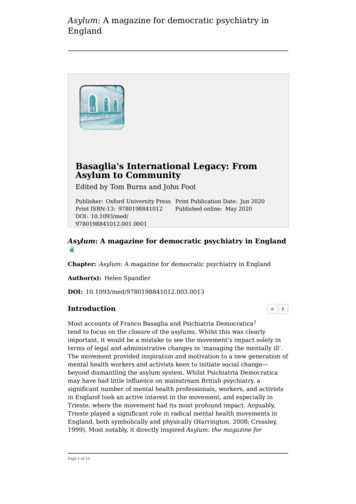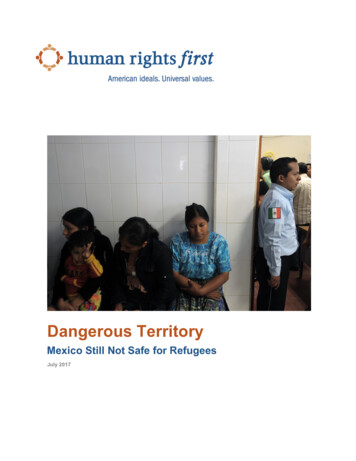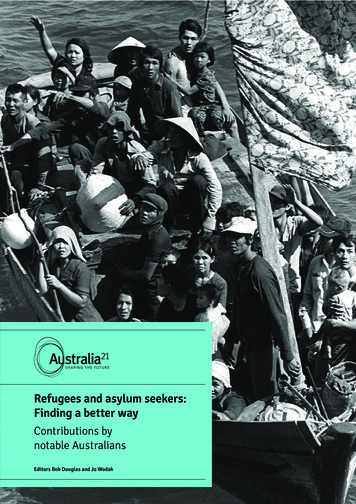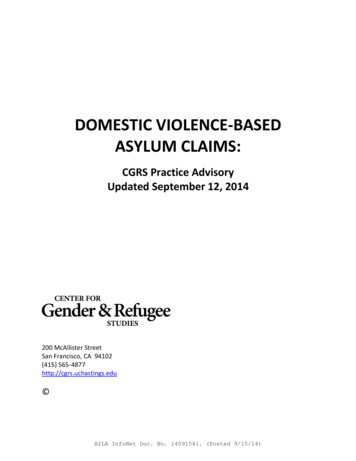
Transcription
Asylum: A magazine for democratic psychiatry inEnglandBasaglia's International Legacy: FromAsylum to CommunityEdited by Tom Burns and John FootPublisher: Oxford University Press Print Publication Date: Jun 2020Print ISBN-13: 9780198841012Published online: May 2020DOI: 10.1093/med/9780198841012.001.0001Asylum: A magazine for democratic psychiatry in EnglandChapter: Asylum: A magazine for democratic psychiatry in EnglandAuthor(s): Helen SpandlerDOI: 10.1093/med/9780198841012.003.0013IntroductionMost accounts of Franco Basaglia and Psichiatria Democratica1tend to focus on the closure of the asylums. Whilst this was clearlyimportant, it would be a mistake to see the movement’s impact solely interms of legal and administrative changes in ‘managing the mentally ill’.The movement provided inspiration and motivation to a new generation ofmental health workers and activists keen to initiate social change—beyond dismantling the asylum system. Whilst Psichiatria Democraticamay have had little influence on mainstream British psychiatry, asignificant number of mental health professionals, workers, and activistsin England took an active interest in the movement, and especially inTrieste, where the movement had its most profound impact. Arguably,Trieste played a significant role in radical mental health movements inEngland, both symbolically and physically (Harrington, 2008; Crossley,1999). Most notably, it directly inspired Asylum: the magazine forPage 1 of 23
Asylum: A magazine for democratic psychiatry inEnglanddemocratic psychiatry which was established in 1986. (For the rest of thischapter I will just refer to it as Asylum.)This chapter uses my research into the first 30 years of Asylum to explorehow it functioned—and, I argue, still functions—as a concrete legacy ofPsichiatria Democratica. Although I was not involved in setting up themagazine, I have been part of its editorial collective for over 20 years andam currently its managing editor. This gives me a unique vantage pointthrough which to analyse these developments. I will use the contents ofthe magazine to explore the movement’s influence on the UK mentalhealth field.2 Mirroring Psichiatria Democratica itself, where themovement was much stronger in Northern Italy, much of this influenceoccurred in the north of England, where I highlight some specificdevelopments. I will suggest that Asylum continues the struggle fordemocratic psychiatry, adapted for contemporary times.I have reservations about reinforcing the status of an individual malepsychiatrist, Franco Basaglia, as so central to the movement, especiallysince he died before most of the major changes and impact occurred.3However, given the focus of this book, and the importance of Basaglia’swriting to the movement, I will reference his work to make this case.The creation of Asylum magazineDespite Psichiatria Democratica’s apparent lack of influenceon mainstream British psychiatry, some psychiatrists and mental healthprofessionals did take an active interest in the movement. For example,Alec Jenner was ‘one of the first psychiatrists in the UK to take a seriousinterest in the [Italian] movement’ (Asylum, 1993, 7(2):29). Based inSheffield in the north of England, Jenner was not known as a radical or ananti-psychiatrist. He had been a research biochemist, was involved inmany trials of psychiatric drugs, and, controversially, helped introducebenzodiazipines into psychiatry. Yet he was intrigued by the radicalpsychiatrists and open-minded enough to think they might havesomething to offer. As such, he became acquainted with R.D. Laing andother psychiatric radicals. He also took a keen interest in theinternational politics of psychiatry. For example, he initiated professionalprotests against the use of psychiatry in oppressing political dissidents inRussia (Asylum, 2007, 16(1):9). He visited Trieste a number of times andwas impressed by what he saw and heard. He was initially reassured thatPsichiatria Democratica ‘did not deny the reality of mental disorder, orthe effectiveness of anti-psychotic drugs’ (Asylum, 2013, 20(1):9).However, he wanted to ‘put medical hegemony under scrutiny’ and ‘posequestions about the appropriate borders of medicine, to learn from othersand shake up ourselves from any complacency’ (Asylum, 2007, 16(1):2).In particular, he wanted to raise awareness in the UK about themovement.Page 2 of 23PRINTED FROM OXFORD MEDICINE ONLINE (www.oxfordmedicine.com). OxfordUniversity Press, 2020. All Rights Reserved. Under the terms of the licence agreement, anindividual user may print out a PDF of a single chapter of a title in Oxford Medicine Online forpersonal use (for details see Privacy Policy and Legal Notice).Subscriber: OUP-Reference Gratis Access; date: 07 June 2020
Asylum: A magazine for democratic psychiatry inEnglandIt is important to note that there was very little of Basaglia’s writingavailable in English until 1987, when Nancy Scheper–Hughes and AnneLovell’s inspired selection of his work was published as Psychiatry InsideOut. Moreover, Basaglia died in 1980, before interest in the movementtook off in the UK. Although he left behind a powerful legacy,misinformation and misunderstanding about the movement grew.Therefore, Jenner, and Shula Ramon4 (a social work academic based inLondon), organized a visit to the UK of four Italian mental healthprofessionals from Trieste who were active members of PsichiatriaDemocratica. At various events in England, during March and April 1984,they spoke about the movement and led discussions about it inManchester, Sheffield, and London.Lyn Bigwood,5 a psychiatric nurse and active trade unionist in York, heardabout the Italians’ visit and contacted Jenner. After talking with her,Jenner persuaded a couple of the Italian visitors to stay on to speak at aconference she was organizing in Wakefield. The event was for ‘rank andfile’ health and social service workers to discuss the implications ofclosing the mental hospitals and of emerging community care policies.The conference ended up being ‘dominated by reports and discussions ofthe Italian experience of just such a policy’ (Asylum, 1986, 1(1):2). At theend of these discussions, a decision was made to set up a magazine tointroduce and promote the idea of democratic psychiatry to a Britishaudience. The three co-founders:—Jenner, Bigwood, and her partner, PhilVirden6—established Asylum to continue discussions and debate thepossibilities of democratic mental healthcare in the UK. The Departmentof Psychiatry at the University of Sheffield had made a slight profit fromthe visit which Jenner was able to use to start publishing the magazine. Itwas produced with the help of a small group of Yorkshire-based mentalhealth workers, ex-patients and other interested parties. Appropriately,given its connections to Psichiatria Democratica, the magazine wasprinted by a local ex-patients’ cooperative for a number of years.Jenner worked with, and mentored, another psychiatrist, Tim Kendall,who also took an active interest in the Italian situation (see Kendall,1996). Kendall was acutely aware of the ‘particularly negative’ views ofTrieste expressed by the British psychiatric establishment and decided tovisit and see the situation for himself (see Kendall, 1996). He recalled thathe ‘slept, ate, breathed’ Trieste for three weeks in 1985. The psychiatricestablishment in the UK often argued that the Italian developments onlyappeared impressive because the situation in Italy prior to the changeswas so appalling, and much worse than the situation in the UK. However,Kendall’s experience of British psychiatry at the time suggested that itwas not much better. He was working in an acute psychiatric ward in ageneral hospital, and on a long-stay ward in the old mental hospital inSheffield. He observed the terrible conditions of patients, including theirphysical abuse and neglect. In comparison, he felt the reforms inspired byPsichiatria Democratica had had a positive impact on Italian mentalhealthcare.Page 3 of 23PRINTED FROM OXFORD MEDICINE ONLINE (www.oxfordmedicine.com). OxfordUniversity Press, 2020. All Rights Reserved. Under the terms of the licence agreement, anindividual user may print out a PDF of a single chapter of a title in Oxford Medicine Online forpersonal use (for details see Privacy Policy and Legal Notice).Subscriber: OUP-Reference Gratis Access; date: 07 June 2020
Asylum: A magazine for democratic psychiatry inEnglandThat same year, 1985, the British Journal of Psychiatry had included anumber of what Kendall called ‘misinformed, outspokenly critical and attimes frankly scornful’ accounts of what it called the ‘Italianexperience’ (Kendall, 1996). Rectifying this situation was undoubtedlyone of Kendall’s motivations for being involved in Asylum magazine. Thetitle ‘Asylum’ was suggested by Barbara Jenner, Alec’s wife.7 It was seenas an ironic nod to the name of the journal which preceded the BritishJournal of Psychiatry.8 At first glance, the title may seem at odds with theItalian movement’s focus on dismantling the asylum system. However, thename was an attempt to reclaim asylum’s original Greek origins as aplace of sanctuary and refuge, a space that cannot be violated. Moreover,the magazine was intended to be as much a sanctuary for unpopular,controversial, and disturbing ideas, as for disturbed and disturbingpeople. Jenner and Kendall were both involved in the early years of themagazine. Jenner’s involvement lasted for many years, until ill healthforced him to retire, whilst Kendall went on to take up various seniorlevel positions with the National Institute of Clinical Excellence (NICE)and the Department of Health (NHS England). Although their pathsdiverged, both Jenner and Kendall kept up contact with their Italiancounterparts. Therefore, it is possible that the movement did influencesome aspects of psychiatry, albeit less directly and explicitly.The magazine’s indebtedness to Psichiatria Democratica is clearlysignalled by its subtitle, ‘a magazine for democratic psychiatry’, and later(in 1993), ‘the magazine for democratic psychiatry’. This was also clear inits mission, recalled by Jenner in 2002:Our aim was to struggle towards achieving what we thought wasthe best of the system in Trieste in the late eighties. There the greatAsylum San Giovanni was now a complex of apartments for expatients, with art studios for everyone, space for theatres andcinema performances and a perpetual discussion of what morecould be done to humanise mental health services story-of-asylum-magazine/)The central idea was to create a forum for open, ongoing debate anddiscussion about what democratic mental health services might look like,especially if they were organized and controlled by the people mostaffected, especially workers ‘on the ground’ and service users, and notjust hospital managers and doctors. The first issue of the magazine waspublished in Spring 1986 and its editorial explained its roots inPsichiatria Democratica, for which it expressed explicit admiration(Figure 13.1).Page 4 of 23PRINTED FROM OXFORD MEDICINE ONLINE (www.oxfordmedicine.com). OxfordUniversity Press, 2020. All Rights Reserved. Under the terms of the licence agreement, anindividual user may print out a PDF of a single chapter of a title in Oxford Medicine Online forpersonal use (for details see Privacy Policy and Legal Notice).Subscriber: OUP-Reference Gratis Access; date: 07 June 2020
Asylum: A magazine for democratic psychiatry inEnglandFigure 13.1Asylum magazine is launched in Spring 1986.This first issue included numerous articles about the politics of mentalhealth, including articles by Jenner about Franco Basaglia and the Italianmental health reforms. It also included an article by Givoanna Battaglia, apsychiatric nurse in Trieste, who gave an illuminating description of thecomplex process involved in nurses being relocated from the hospitalsinto the community, and the ideological shifts and learning involved.Later, Asylum included features about mental health services in othercountries that had been influenced by Psichiatria Democratica. Forexample, it included an article about Sicilian villages where ‘the wholepopulation accepts “madness” and the people manage to livetogether’ (Asylum, 1990, 4(1):10). It also included an article about LiegeBelgium, which had close links with Trieste (Asylum, 1991, 5(1):6–8).More recently, it included an article about a Brazilian mental healthprogramme in Santos which was inspired by the Basaglian experience ofa left-wing government striving for radical change in mental healthservices beyond an individual clinical approach (Asylum, 2002, 13(3):21–23).The next section focuses on developments in England, where Triesteseemed to offer both a philosophical system and an alternative model ofpractice than what was being developed in the UK.Page 5 of 23PRINTED FROM OXFORD MEDICINE ONLINE (www.oxfordmedicine.com). OxfordUniversity Press, 2020. All Rights Reserved. Under the terms of the licence agreement, anindividual user may print out a PDF of a single chapter of a title in Oxford Medicine Online forpersonal use (for details see Privacy Policy and Legal Notice).Subscriber: OUP-Reference Gratis Access; date: 07 June 2020
Asylum: A magazine for democratic psychiatry inEnglandTrieste as inspiration for service developments in EnglandThe closure of the old asylums was not a new policy in the UK. Psychiatrichospitals had been discharging long-stay patients from the 1960sonwards. However, there were concerns about this policy beingaccelerated in the 1980s under a cost-cutting and highly individualisticConservative Government. Given the devastation that this Governmentwas inflicting on industrial working-class communities, there wereconcerns about what their policies would do to mental healthcare. Manymental health workers and activists in the north of England had activelysupported the long and courageous, but ultimately defeated, miners’strike of 1984–1985. Indeed, many had families directly involved in thestrike. They were anxious that patients might be liberated from the oldmental hospitals but end up being isolated, stigmatized, and unsupportedin the community. Government policy of closing the old asylums mighthave seemed similar to the situation in Italy. However, mental healthcareunder Thatcherism would be very different from the collective provisionand workers cooperatives that were the hallmark of services in Trieste.In this context, activists looked to Trieste to see how community carecould be implemented differently (i.e. if they were underpinned by asocialist ideology of collectivism, social responsibility, and cooperation).Trieste was seen as more politically progressive than Laing’s moreindividualized approach which had been popular amongst radicals in the1960s and 1970s. Laing’s approach had been criticized for itsconservative undercurrents by the socialist scholar Peter Sedgwick in hisinfluential book Psychopolitics (Sedgwick, 1982). Many mental healthworkers who had been radicalized in the 1960s and 1970s were lookingfor genuine workable alternatives to the mental health system. In Trieste,they found a system ‘they could connect with, one which articulated theirconcerns in a coherent form’ (Crossley, 1999, p. 814).Jenner’s article in the first issue of Asylum bemoaned the absence of any‘clearly formulated principles and policies’ in the UK for creating‘realistic new ideas or understanding and caring for emotionallydistressed people’ (Asylum, 1986, 1(1):3). He claimed that the ‘medicalmodel’ in the UK had ‘merely been reproduced outside of the hospitalswith people “maintained” on long-term drug therapy, the occasional visitfrom a community nurse and a ten minute out-patientappointment’ (Asylum, 1986, 1(1):3). Many aspects of Trieste appealed toworkers and activists who shared his concerns. In particular, they wereinspired by the creativity, optimism, and sense of community in Trieste.After all, these very qualities were being attacked in the Thatcher years inthe UK. Jenner visited Trieste in August 1985 and recalled how:We were impressed by the political outlook and inclusive services inTrieste and the inspiration of the Basaglias. Amongst other thingsthere we saw the importance of offering to everyone the culturalriches of the arts, entertainment, sport, and freedom of expression.They wanted society in general to be made aware of the mentalPage 6 of 23PRINTED FROM OXFORD MEDICINE ONLINE (www.oxfordmedicine.com). OxfordUniversity Press, 2020. All Rights Reserved. Under the terms of the licence agreement, anindividual user may print out a PDF of a single chapter of a title in Oxford Medicine Online forpersonal use (for details see Privacy Policy and Legal Notice).Subscriber: OUP-Reference Gratis Access; date: 07 June 2020
Asylum: A magazine for democratic psychiatry inEnglandhealth services and the human needs involved. Perhaps moreimportantly they produced an atmosphere of optimism, andcelebration, a conviction too that [by] working together much canbe achieved and richly enjoyed. Everyone could also be shown thatwe are all part of the problems in our own society.(Asylum, 2007, 16(1):2)Activists were impressed by practices like the assemblies in Triestewhere, at least in theory, everybody involved in the services had a right tospeak their mind. These various forums for debate were key to thecollectivization of responsibility, accountability, and anti-institutionalpractice. These practices had been adapted from therapeutic communityideas and practices in the UK. Jenner was attracted to the idea of makingthe society therapeutic, rather than isolating and excluding patients fromsociety and creating psychoanalytically informed mini ‘therapeuticcommunity’ institutions. Jenner recalled wanting to imitate thedevelopment of Italian democratic psychiatry in the UK (Asylum, 2013,20(1):9). He even tried to convince the University of Sheffield’sDepartment of Psychiatry (where he was based) to run a service,modelled on Trieste, in the more deprived areas in Sheffield:because I was very influenced by the Italian idea that apsychiatric service should be part of the community It shouldn'tallow people to ignore what was perhaps causing a lot of theproblems which was social and interaction with other people. Andthe only way to do that was to implant it in a real community.(Asylum, 2007, 16(1):2)Whilst this proposal did not materialize, Jenner, Kendall, and colleaguesattempted to democratize local services, and they believed in themovement’s emphasis on the ‘right of the patient to be part of the debateabout their own treatment’ (Asylum, 2013, 20(1):9). It is worth notingthat whilst service user involvement is more accepted in the UK now,even if it is still underdeveloped, it was very much in its infancy in theearly 1980s. As Kendall later recalled: ‘during its early years, Asylummagazine was viewed by the psychiatric profession as scandalous. Theidea of spending much time listening to patients—let alone listening totheir views on mental disorder or psychiatry—was anathema’ (Asylum,2016, 23(2):3)Asylum drew in others who were inspired by Trieste—most notably, agroup of mental health workers and activists across the Pennines, inManchester, who were also trying to democratize local mental healthservices. For example, members of the Asylum editorial collectiveincluded workers from a new resettlement team in Harpurhey, NorthManchester, set up to ‘resettle’ patients from Springfield PsychiatricHospital in 1987. Like Gorizia, when Basaglia first arrived and where heinitiated the movement (Foot, 2015), Springfield Hospital desperatelyPage 7 of 23PRINTED FROM OXFORD MEDICINE ONLINE (www.oxfordmedicine.com). OxfordUniversity Press, 2020. All Rights Reserved. Under the terms of the licence agreement, anindividual user may print out a PDF of a single chapter of a title in Oxford Medicine Online forpersonal use (for details see Privacy Policy and Legal Notice).Subscriber: OUP-Reference Gratis Access; date: 07 June 2020
Asylum: A magazine for democratic psychiatry inEnglandneeded change. Its physical conditions were described as appalling, andits practices were considered controlling and oppressive (Harrington,2009). The resettlement team was made up of a small number of nursesand support workers who were redeployed from Springfield Hospital. Oneof the resettlement workers was Mark Greenwood—a psychiatric nurse,and an active member of the Asylum collective. He explained that the firstactivity the new team undertook was a week-long overland trip to Triesteby minibus. He recalled that they did not want to be just simply a ‘smallmicro-project’ but, rather, part of a much bigger global movement forsocial change:We were very excited by that, you know, we were very sort of firedup by that [We] proposed, I’m not quite sure where it came from,but we came up with the idea that the new team, which was sort often, eleven of us, would spend the first week of our workingtogether, it amazes me to think that we had the resources to dothis, but we went to Trieste and we organised a very, verymemorable trip overland in a mini-bus all the way to Trieste Oneof their co-operatives ran a hotel and we were put up on people’sfloors and stuff, and we met other people who were there.(Harrington, 2008, p. 245)According to Greenwood, this visit had a profound impact on the groupand became a major influence on how they would go on to frame theirpractice:We were kind of blown away with what we saw. [It was] very much,I suppose, how people would go to kibbutz in the ‘70s and ‘80s andbe inspired by what they saw It kind of honed up it was deeplyinfluential because it gave us lots and lots of ideas Thepredominant influence [was] the ideology that you transferredresources from a hospital base into a community rather than youjust simply settled onto a community and drained the community’sresources. That was a very crucial part of our thinking.(Harrington, 2008, p. 245)In other words, they wanted to harness the resources that had gone intothe psychiatric hospital and ensure that they directly benefitted thecommunities where patients would be resettled.In addition, echoing Trieste, some of the workers were involved in writingpractical proposals, such as the idea of fully integrated community mentalhealth teams, offering a 24-hour, open-access service which wouldeventually replace all hospital-based acute facilities (Harrington, 2008).However, not everyone in the team shared their values and, according toHarrington (2008), this led to a fundamental tension. On the one hand,the ‘radicals’ saw the resettlement team as just one element in a muchbroader ‘Trieste-like’ project to break the power of the hospitals andPage 8 of 23PRINTED FROM OXFORD MEDICINE ONLINE (www.oxfordmedicine.com). OxfordUniversity Press, 2020. All Rights Reserved. Under the terms of the licence agreement, anindividual user may print out a PDF of a single chapter of a title in Oxford Medicine Online forpersonal use (for details see Privacy Policy and Legal Notice).Subscriber: OUP-Reference Gratis Access; date: 07 June 2020
Asylum: A magazine for democratic psychiatry inEnglandtransfer resources into community. On the other hand, the ‘conventionals’still framed the service in terms of traditional professional values and sawthe resettlement team as constituting a discrete service for a particulargroup of clients, connected only tangentially to broader social movements(Harrington, 2008). This division mimicked the splits that were alsoapparent in the Italian situation. It also suggests that although themovement’s impact was significant, it was certainly not widespread and itdid not go unchallenged.Radical mental health workers and academics organized a number ofsubsequent trips to Trieste over the next few years. For example, Asylumincluded an advert for an ‘opportunity to take part in an organised visit toTrieste to see at first hand the work of the mental health service’ whichwould take place in May 1993 (Asylum, 1992/1993, 7(1):7). This visit wasorganized by the third-sector campaigning organization, the ManchesterAlliance for Community Care, some of whose members were involved inAsylum.It may be that Psichiatria Democratica’s influence was strongest in thenorth of England. For example, Asylum magazine has always beenproduced by a collective primarily based in Sheffield and GreaterManchester. In addition, the resettlement team was not only inManchester, but in the more socially and economically deprived north ofthe city, rather than in the more prosperous and seemingly fertileenvironments in the south. This is important not only because radicaldevelopments are often portrayed as London-centric, but also for what itmeans about the conditions for this kind of innovation. Harrington hassuggested that Springfield Hospital’s position as a marginalized andneglected institution may have created the conditions for this kind ofinnovation (Harrington, 2009). Rather like the situation in Gorizia whenBasaglia first arrived there, Springfield Hospital’s relatively marginalized,peripheral, and neglected position—away from regulation and influencefrom more mainstream psychiatric developments—may have allowedactivists more freedom and opportunity to innovate (Harrington, 2009). Itis beyond the scope of this chapter to fully understand Trieste’s impact orinfluence on services. However, it is important not to overstate theinfluence of Trieste on these developments. Other influences were alsoimportant. For example, socialist feminist public health officers were animportant influence on radical developments in North Manchester at thetime.9Page 9 of 23PRINTED FROM OXFORD MEDICINE ONLINE (www.oxfordmedicine.com). OxfordUniversity Press, 2020. All Rights Reserved. Under the terms of the licence agreement, anindividual user may print out a PDF of a single chapter of a title in Oxford Medicine Online forpersonal use (for details see Privacy Policy and Legal Notice).Subscriber: OUP-Reference Gratis Access; date: 07 June 2020
Asylum: A magazine for democratic psychiatry inEnglandWhether Psichiatria Democratica had any lasting impact on servicedevelopment in the UK is difficult to discern. However, it certainly had asignificant impact on the consciousness and confidence of a group ofmental health activists eager to create social change. The ‘pilgrimages’ toTrieste did not just inspire Asylum magazine or specific servicedevelopments: the connections made with, and within, Trieste played animportant part in galvanizing international networks of activists (Crossley,1999).A broader network of mental health activistsThe international lure of Trieste is well-documented (seeDonnelly, 1992). Crossley (1999) has suggested that Trieste functioned asa ‘working utopia’ for mental health activists in the 1980s and 1990s inthe UK (as Kingsley Hall had earlier).10 Working utopias embody concretemini-realizations of the desires of a social movement. They are importantto social movements because they boost the ‘imaginative force’ ofactivists. This allows them to envisage the possibility of alternatives,providing them with added impetus to continue with their struggle forsocial change (Crossley, 1999, p 814). For example, after his visit in 1985,Jenner commented that Trieste was ‘the most obvious remnant of theturbulent 1960s’ (Asylum, 1986, 1(1):4). It thus helped to keep alive someof the radical hopes of that generation.Trieste became a meeting ground for key intellectuals with an interest indemocratic psychiatry. Jenner recalls how it felt like ‘everybody went toTrieste’. He met key figures there who played a part in the emerginginternational intellectual anti-psychiatry scene. For example, he met FélixGuattari (co-author of Anti Oedipus); Robert Castell (author of ThePsychiatric Society); and David Cooper, the South African/British (anti)psychiatrist and author of Psychiatry and Anti Psychiatry (Jenner, inCrossley, 1999, p. 822). Spaces like Trieste were not only important asconcrete ‘working utopias’ which fed activist’s imagination. They alsofunctioned as places for debate and discussion, which in turn created andsustained social networks of activists—and this helped ‘make thingshappen’.Arguably, Trieste played a role in the development of the internationalHearing Voices movement. The Dutch psychiatrist Marius Romme, andSandra Escher, talked about their research on hearing voices at the WorldHealth Organization (WHO) conference which was hosted by Trieste in1988. Key activists who attended the event from the UK took up theseideas and helped translate them into action. They invited Romme andEscher to come to the UK to talk about their research and discussemerging new approaches to hearing voices. Their subsequent visit to theUK was supported and sponsored by Jenner and led to the development ofthe Hearing Voices Network in the UK. Whilst the ideas underpinning analternative approach to hearing voices were already forming, thisconnection helped ignite the movement. This is not to say that Trieste isresponsible, or can take credit, for the international Hearing VoicesPage 10 of 23PRINTED FROM OXFORD MEDICINE ONLINE (www.oxfordmedicine.com). OxfordUniversity Press, 2020. All Rights Reserved. Under the terms of the licence agreement, anindividual user may print out a PDF of a single chapter of a title in Oxford Medicine Online forpersonal use (for details see Privacy Policy and Legal Notice).Subscriber: OUP-Reference Gratis Access; date: 07 June 2020
Asylum: A magazine for democratic psychiatry inEnglandmovement. Credit for this must go to voice hearers themselves and theirallies. However, it is an important part of the overall history of themovement.Critical engagement with TriesteMental health activists in the UK have been criticized for over
Asylum: A magazine for democratic psychiatry in England Page 1 of 23 Publisher: Oxford University Press Print Publication Date: Jun 2020 Print ISBN-13: 9780198841012 Published online: May 2020 DOI: 10.1093/med/ 9780198841012.001.0001 Chapter: Asylum: A magazine for democratic psychiatry in England Author(s): Helen Spandler










